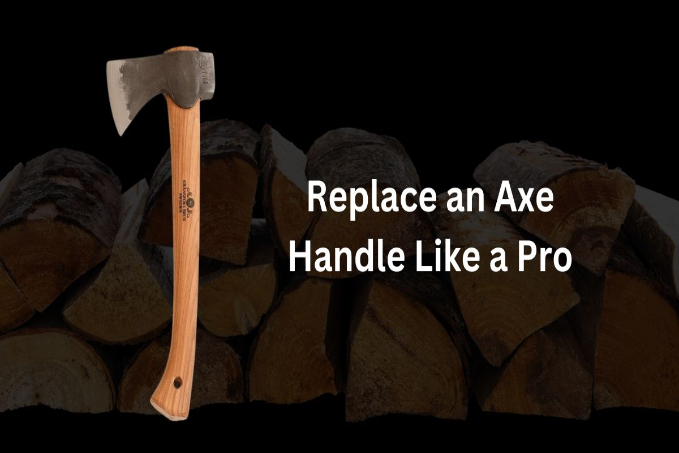It is a few degrees below zero, so you want to get a fire started. To your disappointment, the firewood pieces you collected will not fit into your fireplace. They are simply too large.
Logs are often too big to fit into conventional fireplaces. You need to split them, and a splitting maul will do the job.
Discover how to use this tool to chop wood, and prepare yourself for the task. Make it easier by following a few precise steps.
Should I use a maul or an axe?
A splitting maul, also known a blockbuster, sledge axe or go devil, is a heavy, long-handled axe used for splitting cumbersome logs. It has a head that typically weighs about 8 pounds.
You may wonder why many professional loggers split wood with a maul and not an axe. For many reasons, it is the perfect wood-chopping tool.
The head of the maul is V-shaped. This design allows it to exploit cracks in wood fibers and separate them with precision.
Axe blades, which are thinner than maul blades, tend to jam in wood fibers. If you look closely at a maul, you will notice that it has slightly convex shape. It has a wider head as well. These attributes prevent it from jamming in wood logs.
That means splitting axes can get the job done, but mauls are a much more specialized wood spitted tool.
Preparation for Splitting Logs
Get the wood-chopping process off to a good start. For it to succeed, you must make thorough preparations.
1. Cut your wood to an appropriate length
The shorter logs are, the easier it is to chop them. Most fireplaces accommodate wood pieces of between 16 to 20 inches. Make sure that you cut your wood to a suitable length for your fireplace.
Cut the pieces flat and square, because you need to stand and split them. Crooked pieces of wood will raise the difficulty level of your task.
2. Prepare a chopping block
Get a chopping block ready. Most loggers use a tree trunk. To avoid dangerous recoils, it is important that it is at the right height. Chopping blocks that are six inches off the ground are ideal.
Try not to split wood on the ground. You will exhaust yourself faster because you will have to lift the maul higher for each and every swing.
3. Keep safety in mind
Wood chopping involves some risk. Do all you can to prevent accidents.
Ensure that the area where you want to split wood is not slippery. There should be no hanging debris that may entangle your maul or axe.
Also make sure to wear proper gear. Wear gloves to prevent splinters and put on a pair of safety glasses and work boots as well.
If possible, enlist help. Have a partner to chop wood with, as he or she can assist you if there is an accident.
Using a Maul to Split Wood
Now that you have made all basic preparations, you can get to actually doing the splitting. Splitting wood with a maul is a straightforward process. These simple steps will raise your chances of success. Plus, find out what measures to take if the wood does not split.
Steps to Follow
1. Place the wood in the center of the chopping block
Put the wood in the middle of the chopping block, making sure that it is stable. Chopping wood on a shaky block will cause accidents. You could inadvertently strike your leg, or send wood pieces flying into the air like missiles.
2. Examine the wood thoroughly
Have a close look at the wood and identity hairline cracks. Then, aim in the direction of the cracks so that the wood splits easily.
Different woods break differently, so have a strategy in mind. While oak splits in the center, maple comes apart at the end grains.
Look for places where someone has cut the wood before. These places will likely be crooked or distorted, so it will be hard to cut through them.
3. Take aim
After you have determined where you want to split the wood, stand and rest your maul in that area. You may want to make an indentation as a guide.
4. Chop the wood in an up-down direction
Move the maul in an up-down direction instead of swinging it. Hold it with your weaker hand gripping the end of the handle. Support it with your stronger hand. Bend your knees slightly and lift the maul above your head. Slide your strong hand close to the weaker one.
5. Splitting into smaller pieces
Cut the wood into smaller pieces of about 6 to 8 inches. Place the chopped pieces in progressively smaller stacks to facilitate air circulation.
6. Repeating the process
Go through this process until the wood splits completely. Patience is the name of the game. You will cut the wood efficiently if you use the proper technique.
What to do if the Wood Does Not Split
Do not feel discouraged if the wood does not split on your first try. Wood can be tenacious, and it usually takes several attempts before you can cut it into smaller pieces.
If the bit of the ax remains in the wood, remove it by pulling and twisting. Do not use side to side force as you may break off the handle.
For harder wood, you may choose to turn a maul into a wedge. After driving the maul into a log, hitting its blunt end with a sledge will complete the process of parting the wood.
Things to Remember and Avoid
Splitting wood with a maul or an axe is not rocket science, but it can be dangerous if not done properly. Also, here are a few extra tips for beginners to help you get the most of of your chopping experience.
What to Remember
1. Err on your closest side
When moving your maul, err on your closest side. If you miss on the side that is close to you, your tool will hit the ground. If you miss on your far side, the handle of the maul will hit the wood. The repeated impact may destroy the handle. Constantly having to replace mauls or axes due to broken handles is not picnic, and can hurt your wallet too.
2. Swing a bit ahead of the spot you are aiming for
You should always move your maul such that it is slightly in front of the area you are targeting. Due to your swing having an arc, you’ll be more accurate by aiming a little bit above the center.
3. Age the wood
When possible, store the wood for a year before splitting it. It will start to develop more cracks. Seasoned wood fibers are more malleable than green wood fibers.
4. Moisture
Certain types of wood split faster when wet. Birch, beech, and black oak come apart quickly when they have a little moisture.
What to Avoid
1. Do not use brute strength
Do not use sheer force to split wood or you will tire yourself. Accumulate speed and let the momentum and weight of the axe or maul do the work for you.
2. Do not split wood in unsafe conditions
Trying to handle a maul on slippery or uneven surfaces is a very bad idea. You do not want to bury an 8 pound maul head into you leg.
In Summary
Splitting wood is a relatively simple process. With a little preparation and the right tool, you can be splitting logs and making your own firewood in no time.
Just make sure to always follow safety protocols and you’ll have a a fulfilling and fruitful wood-splitting experience, and if this just seems like way too much manual labor, consider getting a gas or electric powered log splitter instead.
Filed Under: Blog









![How to Fell a Tree in the Direction You Want [ Within 14 Steps ]](https://axeandanswered.com/wp-content/uploads/2023/06/Fell-The-Tree-In-The-Direction-You-Want.jpg)



